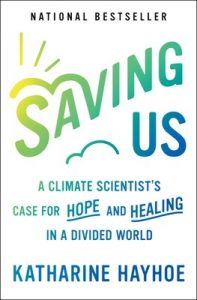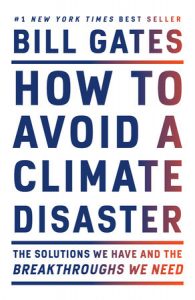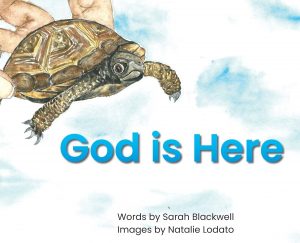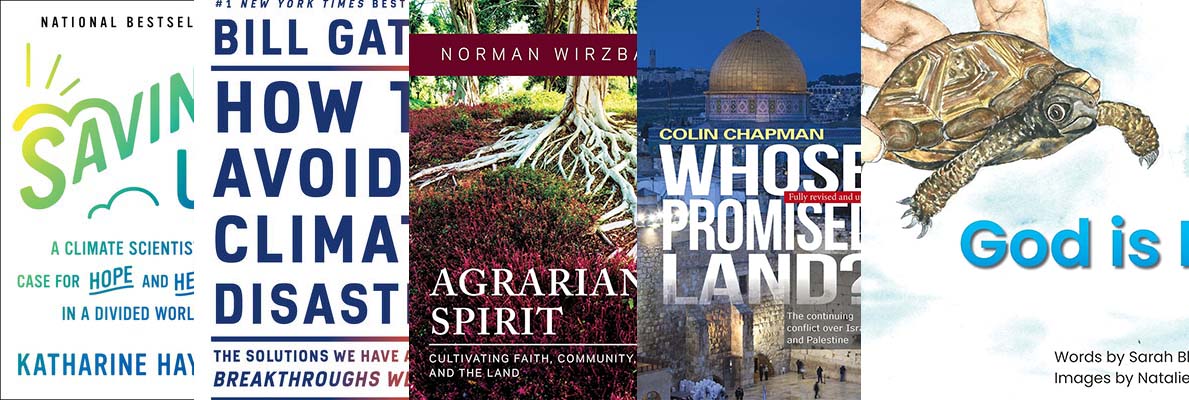No 1. Saving Us, by Katherine Hayhoe
I attended an event in Charlotte in early spring hosted by numerous environmental groups motivated by faith and/or science. I asked an attendee, Karen, who writes a weekly blog titled “Unheating,” what is the best book on the environment that combines faith and science. She and her friend responded immediately, “Saving Us by Katherine Hayhoe.” I ordered the book the next day, read it quickly and concurred completely.
 Hayhoe is a climate physicist who teaches at Texas A&M University and is married to an evangelical pastor. She has acquired a massive following around the world evidenced by her TedTalk in 2018, which has received 4 million-plus views. If you want a brief primer on Hayhoe, listen to her incredible display of wit, witness and weather forecasting in this TedTalk.
Hayhoe is a climate physicist who teaches at Texas A&M University and is married to an evangelical pastor. She has acquired a massive following around the world evidenced by her TedTalk in 2018, which has received 4 million-plus views. If you want a brief primer on Hayhoe, listen to her incredible display of wit, witness and weather forecasting in this TedTalk.
The subtitle of “A Climate Scientist’s Case for Hope and Healing in a Divided World” discloses her motivation in writing this bold yet practical book. Hayhoe can explain the science in terms ordinary citizens can understand. As a Christian, she also knows how the Bible reveals God as Creator and humans are assigned the role of caretakers of the earth. With great insight into the psychological makeup of people, she lays out a pathway for conversations about the harm we are doing to the planet with family and friends resistant to such conversations. She states plainly, “The best thing we can do about climate change is talk about it.”
“The best thing we can do about climate change is talk about it.”
This is already a “go-to” book for me when I’m trying to connect my Christian faith with my scientific understanding of the world.
No. 2. How to Avoid a Climate Disaster, by Bill Gates
In the way Hayhoe connects science to faith to make the case for creation care, Bill Gates, founder of Microsoft and one of the world’s wealthiest men, connects business to the environment. He is a big-picture guy who is interested in the world’s biggest problems and is curious enough to explore potential solutions. In his practical, straight-to-the-point business style, Gates lays out the problem presented by climate change.
 With the help of experts in the fields of physics, chemistry, biology, engineering and political science, he focuses on what must be done to stop the world from entering into an age of environmental disaster.
With the help of experts in the fields of physics, chemistry, biology, engineering and political science, he focuses on what must be done to stop the world from entering into an age of environmental disaster.
Gates wants us to remember two numbers: 51 billion and zero. Fifty-one billion is how many metric tons of greenhouse gases we add to the atmosphere each year. Zero is where we need to be. He explains what net zero emissions is, why we need to move there, and how we can do it. He identifies a number of technological innovations emerging in the markets that will help, yet he understands we can’t simply innovate our way out of this problem.
The authority of this book comes from Gates’ business knowledge of moving from ideas to large scale production.
I loved this book because Gates doesn’t sugarcoat the problem but methodically and practically moves us toward hope. We have the capacity to address climate change, but it means we must change our behaviors, our national policies and the ways we utilize the global economy for the common good of humanity.
Gates has a plan that is worthy of consideration by global leaders and ordinary citizens.
No. 3. Agrarian Spirit, by Norman Wirzba
Hayhoe has combined faith and science, Gates has connected business and science. Norman Wirzba combines philosophy and science to nurture our souls. C3 theological consultant and professor of philosophy and theology at Duke Divinity School, Wirzba calls the faith community back to the land where its roots are — biology, philosophy and ecology.
 I did a podcast with Wirzba which I commend to you, if you want to listen to how he pulls together the church fathers as witnesses to the importance of “the agrarian lifestyle.” Such a lifestyle does not require that we return to the land as farmers, but it does commend our becoming familiar with the land, noticing its needs and how we can cultivate a love for it as a means to deepen our faith.
I did a podcast with Wirzba which I commend to you, if you want to listen to how he pulls together the church fathers as witnesses to the importance of “the agrarian lifestyle.” Such a lifestyle does not require that we return to the land as farmers, but it does commend our becoming familiar with the land, noticing its needs and how we can cultivate a love for it as a means to deepen our faith.
In many ways, Agrarian Spirit is a devotional book, with six of its nine chapters dealing with spiritual exercises about learning: to pray, to see, descent, humility, generosity and hope.
Wirzba, in the genre of the desert fathers, offers the modern world a new place for the soul to live fully embodied. It is a place that lives humbly in the earth, alongside all creatures, plants and bodies of water rather than domineering and exploiting creation.
“This is the kind of book best read bits at a time like a slowly cooked soup on a winter day.”
This is the kind of book best read bits at a time like a slowly cooked soup on a winter day. You read a page or two then practice for the rest of the day. This is a spiritual book grounded in ancient wisdom and earthy insight.
No. 4. Whose Promised Land?, by Colin Chapman
This book is not about the environment but it is about the land, a particular piece of land promised to Abraham. Colin Chapman, a former lecturer in Islamic studies at the Near East School of Theology in Beirut, Lebanon, is a Christian who has spent years living among Arabs and Muslims.
 I was driven back to Whose Promised Land?, published in 2015, with the onset of the Israeli-Palestinian war Oct. 7 this year when Hamas launched its terrorist attack on Israel. Written eight years earlier, Chapman understandably does not reference this particular war. However, his biblical and historical survey of this ongoing conflict is much to be preferred above the heated and violent rhetoric fueled by ignorant passions.
I was driven back to Whose Promised Land?, published in 2015, with the onset of the Israeli-Palestinian war Oct. 7 this year when Hamas launched its terrorist attack on Israel. Written eight years earlier, Chapman understandably does not reference this particular war. However, his biblical and historical survey of this ongoing conflict is much to be preferred above the heated and violent rhetoric fueled by ignorant passions.
The land always has been at the heart of the promises of God toward Abraham and his descendants. Chapman walks the reader through those promises from the initial encounter God had with Abraham, to the views of Jesus on the meaning of those promises. Chapman then reveals the seeds of conflict as the people of promise encountered the inhabitants of the land we now call Palestine. Maps of the lands are shown throughout the history of the Jews who were ruled and sometimes oppressed by Assyrians, Babylonians, Persians, Greeks, Romans and Turks.
Chapman identifies the various political solutions throughout history of the problem of two peoples claiming possession of the same piece, including the 1947 U.N. plan for a two-state solution. He moves on to briefly describe subsequent wars over this land and finally points to shared realities and possibilities for peace.
If you want to vent and read the vitriol of others, I suggest reading social media. If you want understanding and to find a faithful pathway to peaceful coexistence of Jew and Palestinian in this land of promise, I commend this book to you.
No. 5. God is Here by Sarah Blackwell, images by Natalie Lodato
This year I’m putting a children’s book written by Sarah Blackwell, adjunct professor of religion at Wingate University and illustrated by Natalie Lodato, on the list. This book is a resource to encourage children to wonder while they wander.
 The illustrations are rich and detailed, drawing the child to home in on a turtle sitting on a rock or a seed floating in the air. The language uses Seuss-like alliterative rhythm such as “the wiggly worm on my hand while it weaves.” Sidebars allow for deeper exploration of the science of the poem on each page.
The illustrations are rich and detailed, drawing the child to home in on a turtle sitting on a rock or a seed floating in the air. The language uses Seuss-like alliterative rhythm such as “the wiggly worm on my hand while it weaves.” Sidebars allow for deeper exploration of the science of the poem on each page.
Sticking with the poem about worms, the sidebar explains how slimy worms are constantly recycling organic matter into the soil, making it rich and fertile. This is a book that can be read to children who are young or read by older children whose imagination can take a picture and a poem and make it a vibrant reality that stimulates the world in which they live, breathe, play and pray.
Don Gordon is founder and CEO of C3 — Christians Caring for Creation. He also serves as pastor of Trinity Baptist Church in Newton, N.C.


